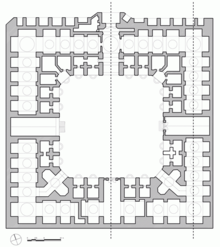Karavanserai

’n Karavanserai of khan (Persies: كاروانسرا kārvānsarā; Turks: kervansaray) was ’n (meestal Persies-geïnspireerde) herberg langs die pad waar reisigers kon rus ná die dag se reis. Karavanserais het die vloei van handel, inligting en mense aan die handelsroetes van Sentraal-Asië, Noord-Afrika en Suidoos-Europa aangehelp.
Die meeste karavanserais was geboue omring deur ’n vierkantige of reghoekige muur met ’n groot genoeg poort sodat groot, swaargelaaide diere soos kamele daardeur kon gaan. Die binnehof was feitlik altyd oop bo en al met die mure langs was kiosks, inhamme en kamers waar handelaars, slawe en diere kon oornag en handelsware gestoor kon word.[1]
In die karavanserais was daar water vir mense en diere, asook geriewe vir was en rituele. Daar was voer vir die diere en winkels waar reisigers hul voorrade kon aanvul of van hul ware verhandel.[2]
Die Persiese woord is ’n samestelling van kārvān (reisiger-karavaan) en sara (paleis, gebou met binnehowe). Dit was ook bekend as ’n khan (Persies: خان,; Turks: han), funduq (in Arabies) of fundaco (in Venesië).
Fotogalery
[wysig | wysig bron]-
Die binnekant van die Karavanserai van Sa'd al-Saltaneh in Qazvin, Iran.
-
Die Karavanserai van sjah Abbas, nou ’n hotel, in Isfahan, Iran.
-
Binne die Orbelianse Karavanserai, Armenië.
-
’n Karavanserai in Karaj, Iran.
-
’n Karavanserai in Shaki, Azerbeidjan.
-
’n Verlate karavanserai in Neyestanak, Iran.
-
Karavanserai van Qalaat al-Madiq, in Noord-Sirië.
-
Khan al-Wazir, Aleppo, Sirië.
-
Sultan Han-karavanserai.
-
Ruïnes van Bara Katra, of Groot Karavanserai, in Dhaka, Bangladesj; gebou deur die Mogolprins Sjah Sjuja.
-
Ruïnes van Shaista Khan Karavanserai in Dhaka, Bangladesj; gebou deur die Mogolse Visekoning Shaista Khan.
-
Toegang tot Anderkilla in Chittagong, Bangladesj.
Verwysings
[wysig | wysig bron]- ↑ Sims, Eleanor. 1978. Trade and Travel: Markets and Caravanserais.' In: Michell, George. (ed.). 1978. Architecture of the Islamic World – Its History and Social Meaning. London: Thames and Hudson Ltd, 101.
- ↑ Ciolek, T. Matthew. 2004-present. Catalogue of Georeferenced Caravanserais/Khans. Old World Trade Routes (OWTRAD) Project. Canberra: www.ciolek.com – Asia Pacific Research Online.
Verdere leesstof
[wysig | wysig bron]- Branning, Katharine. 2002. The Seljuk Han in Anatolia. www.Turkishhan.org, New York, VSA.
- Encyclopædia Iranica, p. 798-802
- Erdmann, Kurt, Erdmann, Hanna. 1961. Das anatolische Karavansaray des 13. Jahrhunderts, 3 vols. Berlin: Mann, 1976, ISBN 3-7861-2241-5
- Yavuz, Aysil Tükel. 1997. The Concepts that Shape Anatolian Seljuq Caravanserais. In: Gülru Necipoglu (red). 1997. Muqarnas XIV: An Annual on the Visual Culture of the Islamic World. Leiden: E.J. Brill, 80-95. Aanlyn beskikbaar by archnet.org/library/pubdownloader/pdf/8967/doc/DPC1304.pdf.
Eksterne skakels
[wysig | wysig bron]- Hierdie artikel is merendeels vertaal vanaf die Engelse Wikipedia-artikel en:Caravanserai
 Wikimedia Commons het meer media in die kategorie Karavanserai.
Wikimedia Commons het meer media in die kategorie Karavanserai.
Text is available under the CC BY-SA 4.0 license; additional terms may apply.
Images, videos and audio are available under their respective licenses.













